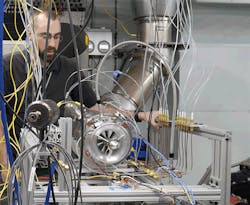Air Force Develops Turbine Totally In-House
Speed is often a must-have in the development of new technologies for the armed forces. As part of accelerated efforts to design and build a new type of turbine engine, the Responsive Open Source Engine (ROSE) was designed, built, and tested by the U.S. Air Force Research Laboratory (AFRL) at Wright-Patterson Air Force Base (Ohio) in just 13 months—the first turbine engine designed, assembled, and tested exclusively in-house. This project by the Aerospace Systems Directorate is evidence of the Air Force’s desire to develop new technologies and prototypes in less time and with less cost.
“We decided the best way to make a low-cost, expendable engine was to separate the development costs from procurement costs,” said Frank Lieghley, Aerospace Systems Directorate Turbine Engine Division senior aerospace engineer and project manager. Since the design and development of the turbo engine were performed in-house, the Air Force owns the intellectual property (IP) behind the engine. With command of the IP, once the engine design is tested and qualified, there’s flexibility in the choice of manufacturers to produce the engine. That means small production runs are possible, rather than being held to larger production runs from large prime contractors simply to minimize costs.
A new turbine engine for smaller platforms was designed, built, and tested in-house by the U.S Air Force Research Laboratory at Wright-Patterson AFB. (Courtesy of AFRL)
By developing the engine in-house, costs have been reduced dramatically over competitive alternative engines. The lower cost of the small engine creates opportunities to develop a new class of air vehicles. “There’s no end to what might be done, but it’s all enabled by inexpensive production,” said Dr. Greg Bloch, Aerospace Systems Directorate Turbine Engine Division chief engineer. “It’s the ability to turn the economics of warfare around.”
The ROSE project is not meant as a strategy to replace prime contractors, but as an optional design and development path when needed. As explained by Lt. Col. Ionio Andrus, the Aerospace Systems Directorate Turbine Engine Division deputy division chief, “We’re not trying to compete with our commercial partners; we are leveraging an underutilized sector to meet Air Force needs.”
By working with other AFRL organizations, including the Materials and Manufacturing Directorate and the Air Force Institute of Technology, the engine design team leveraged enormous available internal expertise in different areas to help speed the project. It’s the first example of what may be possible for many lower-cost, technological advances in the future.
About the Author
Jack Browne
Technical Contributor
Jack Browne, Technical Contributor, has worked in technical publishing for over 30 years. He managed the content and production of three technical journals while at the American Institute of Physics, including Medical Physics and the Journal of Vacuum Science & Technology. He has been a Publisher and Editor for Penton Media, started the firm’s Wireless Symposium & Exhibition trade show in 1993, and currently serves as Technical Contributor for that company's Microwaves & RF magazine. Browne, who holds a BS in Mathematics from City College of New York and BA degrees in English and Philosophy from Fordham University, is a member of the IEEE.


